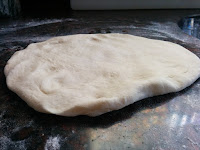 Whenever I make bread, the shape is either that of a loaf or a "free form" which basically translates to "I have no control over the shape". So I took a piece of aluminium drain pipe (8cm diameter), cut it in half and folded it over so that I have two perfect moulds into which I could bake French-style baguettes.
Whenever I make bread, the shape is either that of a loaf or a "free form" which basically translates to "I have no control over the shape". So I took a piece of aluminium drain pipe (8cm diameter), cut it in half and folded it over so that I have two perfect moulds into which I could bake French-style baguettes. The actual bread recipe is simple enough: flour (as much as you need), salt and about a tablespoon of olive oil. I added grated cheese as an alternative. To this, add yeast that has proved in a bowl with warm water and two teaspoons of sugar. Mix everything together ans slowly add more warm water until you get a soft dough. Knead until smooth, place in a bowl, cover and leave in a warm, dark place until the dough doubles in size.
The actual bread recipe is simple enough: flour (as much as you need), salt and about a tablespoon of olive oil. I added grated cheese as an alternative. To this, add yeast that has proved in a bowl with warm water and two teaspoons of sugar. Mix everything together ans slowly add more warm water until you get a soft dough. Knead until smooth, place in a bowl, cover and leave in a warm, dark place until the dough doubles in size.Remove from bowl, punch out the air and cut into two equal pieces. Roll out into a disc (about the same size as your mould is long) and then roll it up into a cigar-shape. Place his into your mould and allow to prove again.
Bake in a hot oven and should you desire the bread to be hard and crispy on the outside, use a spray bottle with water, every few minutes.
Follow me on Instagram: johncavernelis
Check out my Facebook page: Simple Foodies


































